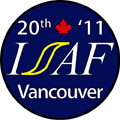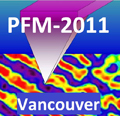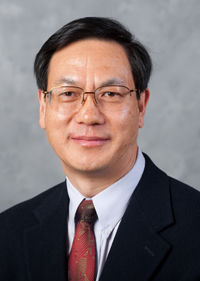Zhong Lin Wang |
Dr. Zhong Lin (ZL) Wang is the Hightower Chair in Materials Science and Engineering, Regents' Professor, Engineering Distinguished Professor and Director, Center for Nanostructure Characterization, at Georgia Tech. Dr. Wang is a foreign member of the Chinese Academy of Sciences, member of European Academy of Sciences, fellow of American Physical Society, fellow of AAAS, fellow of Microscopy Society of America and fellow of Materials Research Society. He has received the 2001 S.T. Li prize for Outstanding Contribution in Nanoscience and Nanotechnology, the 1999 Burton Medal from Microscopy Society of America, and the 2009 Purdy award from American ceramic society. Dr. Wang has made original and profound contributions to the synthesis, discovery, characterization and understanding of fundamental physical properties of oxide nanobelts and nanowires, as well as applications of nanowires in energy sciences, electronics, optoelectronics and biological science. He invented and pioneered the in-situ technique for measuring the mechanical and electrical properties of a single nanotube/nanowire inside a transmission electron microscope (TEM). His breakthroughs in developing nanogenerators establish the principle and technological road map for harvesting mechanical energy from environment and biological systems for powering a personal electronics. Dr. Wang is the world’s top 5 most cited authors in nanotechnology and materials science. His entire publications have been cited for over 38,000 times. The H-index of his citations is 93. Details can be found at:http://www.nanoscience.gatech.edu/zlwang |
|
School of Materials Science and Engineering, Georgia Institute of Technology, Atlanta USA |
||
Nanogenerators and Piezotronics Developing wireless nanodevices and nanosystems is of critical importance for sensing, medical science, environmental/infrastructure monitoring, defense technology and even personal electronics. It is highly desirable for wireless devices to be self-powered without using battery. This is a new initiative in today’s energy research for mico/nano-systems in searching for sustainable self-sufficient power sources [1]. We have invented an innovative approach for converting nano-scale mechanical energy into electric energy by piezoelectric zinc oxide nanowire arrays [2]. As today, a gentle straining can output 1-3 V from an integrated nanogenerator, using which a self-powered nanosensor has been demonstrated. A commercial LED has been lid up [3-5]. Ref.: [1] Z.L. Wang, Scientific American, 298 (2008) 82-87; [2] Z.L. Wang and J.H. Song , Science, 312 (2006) 242-246; [3] R.S. Yang, Y. Qin, L.M. Dai and Z.L. Wang , Nature Nanotechnology, 4 (2009) 34-39; [4] S. Xu, Y. Qin, C. Xu, Y.G. Wei, R.S. Yang, Z.L. Wang, Nature Nanotechnology, 5 (2010) 366; [5] G. Zhu, R.S. Yang, S.H. Wang, and Z.L. Wang , Nano Letters, 10 (2010) 3151; [6] Z.L. Wang, Adv. Mater., 19 (2007) 889-992; [7] W.Z. Wu, Y.G. Wei and Zhong Lin Wang , Adv. Materials, DOI: adma.201001925; [8] Y.F. Hu, Y.L. Chang, P. Fei, R.L. Snyder and Z.L. Wang, ACS Nano, 4 (2010) 1234–1240; [9] Research supported by DARPA, DOE, NSF, Airforce, NIH, Samsung. For details:http://www.nanoscience.gatech.edu/zlwang/ |
||
|







